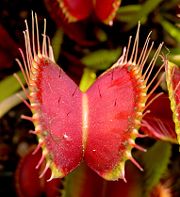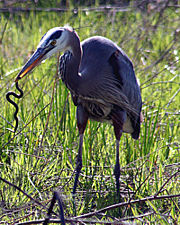Carnivore
2008/9 Schools Wikipedia Selection. Related subjects: Biology
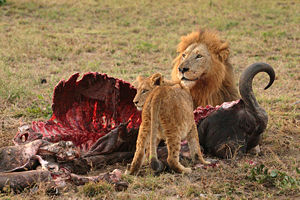
A carnivore (IPA: /ˈkɑrnɪvɔər/), meaning 'meat eater' (Latin carne meaning 'flesh' and vorare meaning 'to devour'), is an animal with a diet consisting mainly of meat, whether it comes from animals living ( predation) or dead ( scavenging).
In a more general sense, animals are loosely considered carnivores if their feeding behaviour consists of preying on other animals rather than grazing on plants. There are many predatory invertebrates, for example arthropods such as spiders or mantises and various species of predatory land snails and sea snails.
Animals that subsist on a diet consisting only of meat are referred to as obligate carnivores.
Plants that capture and digest insects are called carnivorous plants. Similarly fungi that capture microscopic animals are often called carnivorous fungi.
The designation " hypercarnivore" is used to describe animals that exclusively feed on animal tissue. Additionally, it is used in paleobiology to describe taxa of animals which have an increased slicing component of their dentition relative to the grinding component.
Classification
Carnivores that eat insects and similar invertebrates primarily or exclusively are called insectivores, while those that eat fish primarily or exclusively are called piscivores. Carnivory that entails the consumption of members of an organism's own species is referred to as cannibalism. This includes sexual cannibalism and cannibalistic infanticide.
The word "carnivore" sometimes refers to the mammalian Order Carnivora, but this is misleading. Although many Carnivora fit the first definition of being exclusively meat eaters, not all do. For example, bears are members of Carnivora that are not carnivores in the dietary sense, and pandas are almost exclusively herbivorous. Likewise, some full-time (dolphins, shrews) and part-time (humans, pigs) predatory species among mammals, let alone all carnivorous non-mammals, are not members of Carnivora.
Outside of the animal kingdom, there are several genera containing carnivorous plants and several phyla containing carnivorous fungi. The former are predominantly insectivores, while the latter prey mostly on microscopic invertebrates such as nematodes, amoeba and springtails.
Prehistoric mammals of the crown-clade Carnivoramorpha (Carnivora and Miacoidea without Creodonta), along with the early Order Creodonta, and some mammals of the even early Order Cimolesta, were true carnivores. The earliest carnivorous mammal is considered to be the Cimolestes that existed during the Late Cretaceous and Tertiary Periods in North America about 65 million years ago. Most species of Cimolestes were mouse to rat-sized, but the Late Cretaceous Cimolestes magnus reached the size of a marmot, making it one of the largest Mesozoic mammals known (20-60g). The cheek teeth combined the functions of piercing, shearing and grinding, and the molars of Palaeoryctes had extremely high and acute cusps that had little function other than piercing. The dentition of Cimolestes foreshadows the same cutting structures seen in all later carnivores. While the earlier smaller species were insectivores, the later marmot-sized Cimolestes magnus probably took larger prey and were definitely a carnivore to some degree. The cheek teeth of Hyracolestes ermineus (an ermine-like shrew - 40g) and Sarcodon pygmaeus ("pygmy flesh tooth" - 75g), were common in the Latest Paleocene of Mongolia and China and occupied the small predator niche. The cheek teeth show the same characteristic notches that serve in today's carnivores to hold flesh in place to shear apart with cutting ridges. The theropod dinosaurs such as Tyrannosaurus rex that existed during the late Cretaceous, although not mammals, were "obligate carnivores".
Obligate carnivores
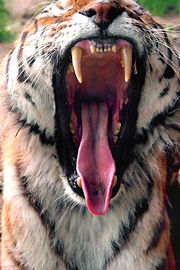
An obligate or true carnivore is an animal that must eat meat in order to thrive. Hypercarnivores present specialized dentition for a meat-only diet. They may consume other products presented to them, especially animal products like eggs and bone marrow or sweet sugary substances like honey and syrup, but, as these items are not essential, they do not consume these on a regular basis. True carnivores lack the physiology required for the efficient digestion of vegetable matter, and, in fact, some carnivorous mammals eat vegetation specifically as an emetic. The domestic cat is a prime example of an obligate carnivore, as are all of the other felids.
Characteristics of carnivores
Characteristics commonly 'associated' with carnivores include organs for capturing and disarticulating prey (teeth and claws serve these functions in many vertebrates) and status as a predator. In truth, these assumptions may be misleading, as some carnivores do not hunt and are scavengers (though most hunting carnivores will scavenge when the opportunity exists). Thus they do not have the characteristics associated with hunting carnivores. Carnivores have comparatively short digestive systems as they are not required to break down tough cellulose found in plants.
Plant material
In most cases, some plant material is essential for adequate nutrition, particularly with regard to minerals, vitamins and fibre. Most wild carnivores consume this in the digestive system of their prey. Many carnivores also eat herbivore dung, presumably to obtain essential nutrients that they could not otherwise obtain, since their dentition and digestive system do not permit efficient processing of vegetable matter.
List of carnivores
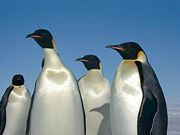
- Felines, ranging from domestic cats to lions, tigers, cheetahs and leopards.
- Some Canines, such the Gray Wolf and coyote. Domestic dogs and red foxes are broadly considered carnivorous but are able to digest some vegetable matter making them somewhat omnivorous. The Smithsonian Institution has listed them as carnivores, because of their dental makeup and digestive tract..
- Hyenas
- Some mustelids, including ferrets
- Polar Bears
- Pinnipeds (seals, sea lions, walruses, etc.)
- Dolphins
- Whales
- Microbats
- Carnivorous Marsupials, such as the Tasmanian Devil
- Birds of prey, including hawks, eagles, falcons and owls
- Scavenger birds, for example vultures
- Several species of waterfowl including gulls, penguins, pelicans, storks, and herons
- Anurans (frogs and toads)
- Snakes
- Some lizards, such as the Gila Monster and all monitor lizards.
- Crocodilians
- the Komodo dragon also known as the Komodo Monitor, Komodo Island Monitor
- Some turtles, including the snapping turtle and most sea turtles
- Sharks
- Many bony fish, including tuna, marlin, salmon, and bass
- Octopuses and squid
- Cone shells
- Spiders, scorpions, and many other arachnids
- Mantises, Giant water bugs, and many other insects
- Cnidarians
- Sea stars
